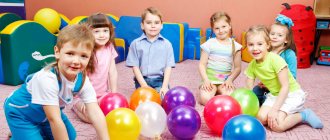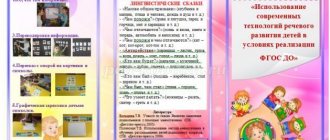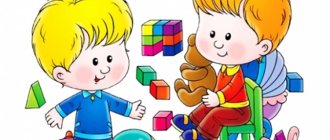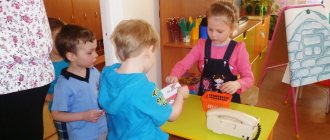How should the child's personality be considered?
In this teaching, the child’s personality is a priority subject; It is its development that is the main goal of the entire educational system. In general, for a long time this approach has been called anthropocentric. The main thing that a teacher should always remember is that children should experience full respect and support in all their creative endeavors. The teacher and student must work together, jointly achieving the tasks they have set for themselves.
In general, the technology of a person-centered approach includes the concept that the educational process should be as comfortable as possible for the child; it should only give him a feeling of security and a desire to develop his abilities further.
Simply put, the child needs to be given as much independence as possible. Having the opportunity to choose, a teenager develops much better, since he does this not under the influence of external factors, but only thanks to his own desire and desire to learn.
Humane and personal approach to the child
In this case, the center of the educational program should be the totality of the personal qualities of each of the children you teach. The school here has only one specific goal - to awaken the dormant inner strengths and talents of the ward, to use them for the harmonious development of the young personality. The following ideas prevail in this approach:
- The personality is put “at the forefront”. The features of the entire educational process depend on its characteristics. Thus, student-oriented technologies in school imply maximum friendliness of the learning process to the student himself.
- Pedagogical relations with students should be as democratic as possible. Teacher and student are equal partners, not leader and follower.
- Let's say “No” to direct coercion as a method that often does not give a real positive effect in the long term.
- An individual approach is not only welcomed, but is also the main method used in training.
- In addition, personality-oriented technologies (Yakimanskaya in particular) provide for the need to explain to the child the concepts of “personality” and “personal freedom”.
Pedagogization of the environment
Historically, it was the school that became perhaps the most important social institution, the importance of which is difficult to overestimate. Along with the family and social environment, it is the most important factor that determines the further development of the individual.
The results of this formation are determined by a combination of all three factors. Here we come to the meaning of this method, which, again, has long been used by experienced domestic teachers. We are talking about the extreme importance of interaction with parents and public organizations, as this will create the most favorable environment for the formation of the child’s personal qualities.
Classification of the concept
Why do you think the term “person-centered technologies” is used in education? More precisely, why is this concept spoken of in the plural? It's simple. These are actually technologies, there are several of them. In the form of a table, we will not only describe them, but also give a brief but comprehensive description of each variety. So, what are their types? Person-centered technologies fall into six main categories, which are described below.
| Technology name | Her characteristics |
| Research | The main feature is independent research of the material. "Discovery through knowledge." A large amount of handouts and visual material is required, from which students will learn the most important information |
| Communicative | As can be understood from the name, when conducting a lesson, it is necessary to place maximum emphasis on the discussion of the material being studied by the students. “Truth is born in dispute”! If you have already managed to arouse children’s interest in the topic under discussion, this form of lesson can spur it even more. |
| Gaming | This technique is used not only by student-oriented technologies in preschool educational institutions. The game is important not only for preschoolers: for example, for high school students it is extremely important to conduct lessons that model professional difficulties and methods for solving them, which can be encountered everywhere in adult life. |
| Psychological | In this case, trainings and seminars are required. Their goal is one. The student must independently choose his preferred area and method of further study of the topic |
| Activity | The name is not entirely clear, but in practice everything is as simple as possible: the child participates in the preparation of educational material, feels like a subject of the educational process |
| Reflective | Each student must be able to independently analyze the results of the last lesson, work on mistakes, formulate competent and specific questions to the teacher in case of any ambiguities. |
Education concept
In this case, student-centered educational technologies reflect the main trends common in modern schools:
- School should be not only a source of knowledge, but also a means of educating the younger generation. In principle, Soviet teachers knew this very well, but today for some reason this most important function is constantly forgotten.
- As in all previous examples, the main attention must be paid to the student’s personality.
- The orientation of education should be humanistic; adolescents should be instilled with universal ideas of humanism and compassion.
- It is extremely important to develop the creative abilities of every child, without exception.
- In schools of regional centers, it is necessary to pay increased attention to the revival of national traditions and customs of small nations, whose representatives live there.
- Collective education must be combined with an individual approach.
- Goals should be set from simple to complex tasks, adequately assessing the abilities of each individual student.
Didactic activating and developmental complex
The main question: what and how to teach students?
In this case, the content of the curriculum itself is only a means for the dynamic and harmonious development of the student’s personality, and not as the sole goal of the school. Positive stimulation of students is widely used. It is necessary to introduce teaching methods that directly stimulate children to learn something new. Improving the educational process should be carried out on the basis of didactic ideas, which are described in the works of R. Steiner, V. F. Shatalov, S. N. Lysenkova, P. M. Erdniev, and other specialists, who today are generally recognized “meters” of didactic method.
What is it?
This term first appears in the works of psychologist Carl Rogers.
He is the author of the proof of the theory that for successful pedagogical and psychotherapeutic activities, in general, the same approach is necessary. Rogers says that for success in these matters, the ability to empathize with another person, accepting his personality without any additional conditions, is extremely important. In domestic pedagogical circles, the term “personally-oriented technologies” is considered as one of the methods of interaction in which the teacher ensures the most harmonious development of the child’s personality and his abilities based only on those qualities that are characteristic of a particular individual.
Brief historical background
A long time ago, that is, in the 17th-18th century, there lived a landowner in Rus'. And he was famous for the fact that each of his serfs lived richly, and was also known as a rare craftsman in some area. The neighbors were jealous and surprised: where did the master get so many smart, talented people?
One day a local idiot came to see him. He was good for nothing: he didn’t really know how to work in the fields, nor was he trained in crafts. Anyone else would have given up on the wretched man, but the landowner did not give up, watching this strange man for a long time. And he noticed that the “fool” could sit for days on end polishing a small piece of glass with his sleeve, bringing it to the state of rock crystal.
Just a year later, the former poor man was considered the best glass washer in all of Moscow, his services were so popular that the former serf, who by that time had long since bought his freedom, compiled a list of those willing almost six months in advance...
Why did we tell all this? The point is that this example is a classic person-oriented technology “in the field.” The landowner knew how to look closely at each individual and identify the person’s talents that were inherent in him initially. In schools and preschool institutions, teachers face exactly the same tasks.






